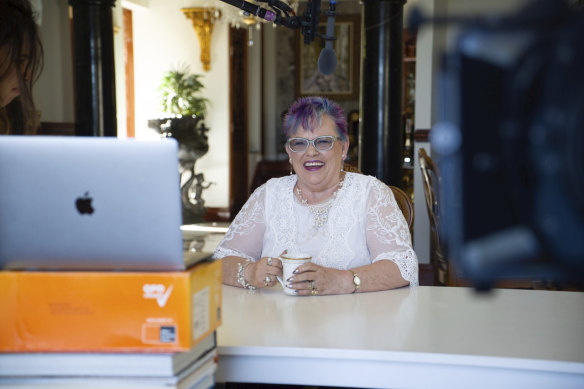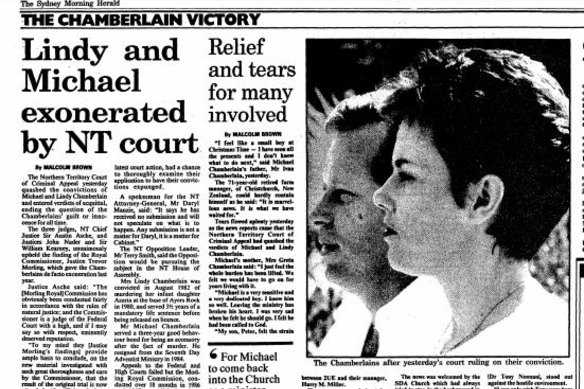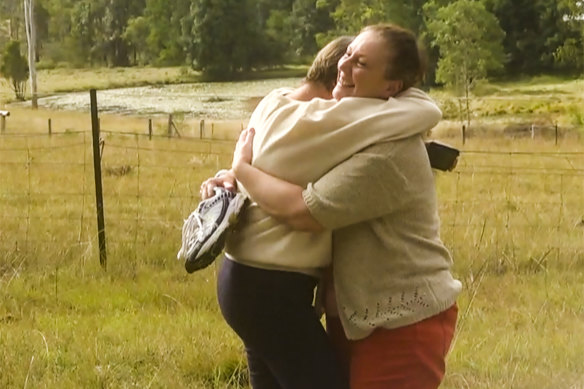Why Lindy Chamberlain feels forced to speak out after Kathleen Folbigg’s pardon

Save articles for later
Add articles to your saved list and come back to them any time.
Lindy Chamberlain-Creighton has called for an overhaul of the way scientific evidence is assessed in criminal trials after Kathleen Folbigg was pardoned and freed from prison 20 years into her sentence over the deaths of her four young children.
In a rare intervention in public debate, Chamberlain-Creighton said her wrongful conviction over the 1980 death of her nine-week-old daughter Azaria, who disappeared during a camping trip at Uluru, had “started highlighting” problems in the way scientific evidence was used in court.
Lindy Chamberlain-Creighton (left) and with her then-husband Michael Chamberlain (right) says her wrongful conviction and the case of Kathleen Folbigg (centre) have highlighted the need for changes to the justice system to help assess scientific evidence.Credit: Glenn Campbell, Mick Tsikas, Michael Rayner
“Kathleen’s case has once again really slapped this in the public’s face,” Chamberlain-Creighton told The Australian Women’s Weekly in an interview published on Thursday.
“For years, I’ve had something on my mind that needs fixing, needs comment,” she said. “Kathleen Folbigg’s case has made me think that perhaps the public is now ready to listen to what I have to say.”
Folbigg, 56, served 20 years of a minimum 25-year prison sentence after being convicted in 2003 of the murder of three of her children, Patrick, Sarah and Laura, and the manslaughter of her first child, Caleb.
She was granted an unconditional pardon in June after a landmark inquiry concluded there was reasonable doubt about her guilt, based on scientific evidence pointing to potential natural causes of death.
“Kathleen’s case has once again really slapped this in the public’s face”: Lindy Chamberlain-Creighton.
The jury in Chamberlain-Creighton’s trial heard evidence from a forensic scientist suggesting arterial blood was found in the Chamberlains’ car. A royal commission concluded in 1987 that the substance was sound-deadening material commonly found in cars.
“In the testing, the difference between copper and blood is a matter of seconds,” Chamberlain-Creighton said.
Chamberlain-Creighton was jailed for murder in 1982 but released in 1986 after Azaria’s jacket – a key piece of evidence – was found at Uluru.
The royal commission subsequently concluded that a judge hearing the same evidence as it heard would have been obliged to direct the jury to acquit Lindy and her then-husband Michael, who had been convicted as an accessory but not imprisoned. Michael Chamberlain died in 2017.
It was me way back then, but there have been many since. This can happen to anyone.
The Chamberlains were pardoned in 1987 and their convictions quashed in 1988. They received $1.3 million in compensation in 1992. A fourth inquest in 2012 reached the same finding as the first: Azaria had died “as the result of being attacked and taken by a dingo”.
Chamberlain-Creighton, who remarried in 1992, said an independent panel of experts could help assess scientific evidence used in criminal trials.
“So, if it’s blood evidence, you have blood specialists looking at it. They look at it and say, ‘That’s inaccurate, that’s irrelevant, this is the only bit you can rely on.’ So that is the only piece of evidence sent to the jury.
“It needs to be a rolling panel of experts who are not always on duty. No one knows who is on which case, so they can’t be bribed.”
The Sydney Morning Herald reports in September 1988 on the Northern Territory Court of Criminal Appeal quashing the Chamberlains’ convictions over the death of their daughter Azaria, who was taken by a dingo at Uluru.Credit: Fairfax Media
Chamberlain-Creighton said that “what I’m proposing won’t fix everything, but it will be a start”.
“In order to get something like this going, the public needs to get behind a groundswell to give it momentum. It was me way back then, but there have been many since. This can happen to anyone.”
The Folbigg inquiry heard expert evidence that a genetic variant Kathleen shared with her daughters might cause cardiac arrhythmias – irregular heart rhythms – and sudden unexpected death. It also heard Patrick might have died as a result of an underlying neurogenetic disorder such as epilepsy.
The genetic variant was discovered after Folbigg’s trial. An earlier inquiry in 2019 heard evidence about the mutation but did not consider it persuasive.
Kathleen Folbigg (right) reunites with friend Tracy Chapman after her release from prison.Credit: Nine News
The second inquiry also heard psychological and psychiatric evidence about the interpretation of Folbigg’s diaries – a key plank of the prosecution’s circumstantial case. This evidence had never been heard before. No expert concluded the diaries contained clear admissions of criminal guilt.
Chamberlain-Creighton said she still received letters from people touched by her story, including a recent letter from a woman who apologised for not believing her during her trial.
“It takes a lot of guts to do that,” she said. “I think letters like this are absolutely beautiful.”
Start the day with a summary of the day’s most important and interesting stories, analysis and insights. Sign up for our Morning Edition newsletter.
Most Viewed in National
From our partners
Source: Read Full Article



